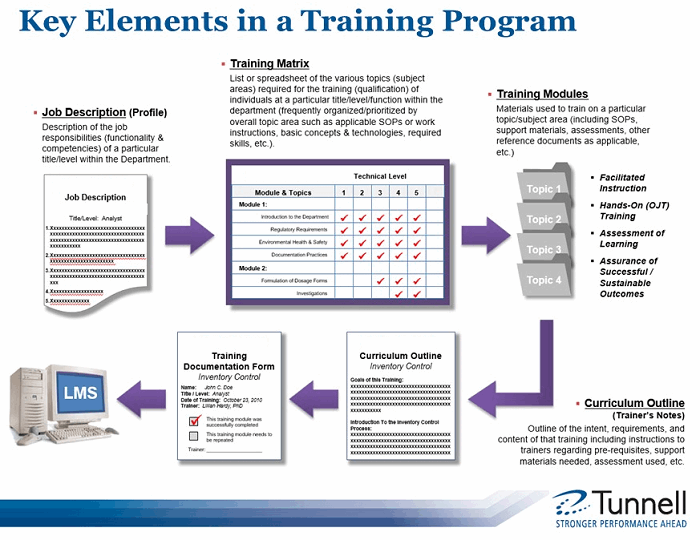10 Steps To Develop A Sustainable Training Program For Pharma Operations
By Al Riles, Tunnell Consulting

Investing in training for employees in the life sciences and biopharmaceuticals industries generates quantifiable returns that go far beyond simply imparting specific, task-oriented knowledge. For example, effective and thoughtfully planned onboarding and sustainable training are key elements in attaining a culture of quality throughout the organization. Furthermore, inadequate training contributes to process and product variability.
Life science organizations must comply with FDA guidelines associated with 21 CFR 211, which provide direction for manufacturing, processing, packing, and handling of a drug product. The regulations require companies to write and implement standard operating procedures (SOPs) that specify guidance for key activities. The regulations also require all employees and supervisors to be trained according to his/her function, thereby ensuring each person is capable of performing their assigned tasks. Life science companies that embrace and implement a quality culture ensure employees are optimally trained before touching the product, therefore safeguarding and protecting the health and well-being of the general public.
Development of a successful and sustainable training program calls for more than just good materials. It requires appropriate policies for guidance, as well as an infrastructure to ensure proper development, deployment, and administration. It must be adaptable, sustainable, and support the goals of both the department and the organization as a whole.
To accomplish this, an integrated quality/human resources (HR) systems approach is recommended for the development and deployment of training. The training should be implemented in pre-defined modules and phases, and it must be aligned and/or integrated with other quality and HR development initiatives, including the current training program infrastructure. The following 10 steps are recommended to develop a viable training program.
1. Identify needs with management and staff.
In identifying and assessing training needs, it’s important to know what the organization is trying to achieve. The analysis will identify organizational needs, job and related tasks that must be learned, competencies and skills required to perform the job, and employees who need training. For example, the needs analysis will help determine training required based on laws such as the Americans with Disabilities Act (ADA), Family and Medical Leave Act (FMLA), and Occupational Safety and Health Administration (OSHA) regulations — and on changes in technology and automation. It also identifies knowledge, skills, attitudes, and abilities required to achieve optimal performance.
2. Identify internal subject matter expert (SMEs) partners.
SMEs are the content experts. They provide specific, detailed information on the topic at hand, and they can contribute to the design of the training program by ensuring the course content is focused on the learner’s needs. By doing so, they help ensure that courses are effective and satisfy business objectives. In addition, SMEs are aware of the technical processes and the job skill requirements for each curriculum. Therefore, they are effective in performing technical and skills training, sharing knowledge and information, and transferring learning.
3. Develop a steering committee.
Providing support and guidance, the steering committee ensures learning goals and initiatives are aligned with business priorities and changing organizational needs. The committee should be knowledgeable of the strategic implications of the training and its related outcomes. Steering committee members should be key stakeholders (executives and senior leadership) who are responsible for providing guidance on the company’s strategic direction.
4. Conduct a current state assessment.
The current state assessment is based on the following three components:
- Organizational skills: Does the organization possess the knowledge and abilities required to achieve the strategic objectives identified in step #1?
- Occupational skills: Do employees possess the skills, knowledge, and abilities required to do the job?
- Individual Assessment: How is each employee performing? What are the gaps and required training needs?
The assessment identifies who needs training and what type of training they need. It also enables identification of the training that is critical to bridging gaps and enhancing company performance.
5. Identify strengths and gaps.
To identify strengths and gaps, answer the following questions:
- What is the organization trying to accomplish?
- What are the recent process or procedure changes?
- What skills are needed for organizational success?
- What is the current skill level of each employee?
- What resources are available for training?
6. Form a module development team (or teams).
The module development team determines what the training content should include, based on what is needed to fill identified gaps and support learning objectives. The team also selects the delivery mode (e.g., web–based vs. mentoring) and style (e.g., self-paced or instructor-led). Selection of the most appropriate delivery mode and style often results in better employee morale and improved retention.
7. Develop/review the draft modules.
In creating the draft modules, it is important to:
- Identify the training support material/resources required to reinforce each module (SOPs, basic concepts, etc.).
- Select current staff members who exhibit best practices and engage them as module developers and trainers.
- Develop draft curricula with lists of modules to be included and/or developed (by technical level, etc.).
8. Conduct pilots of each module. Mentor and certify trainers.
Pilot testing provides an opportunity to identify, assess, and correct any issues before the training is fully rolled out. One pilot training best practice is to assess the following key characteristics:
- Clarity – Determine if the content is understood and the exercises are easily followed.
- Accuracy – Evaluate the training material to ensure it is current, correct, and complete.
- Performance – Ensure the exercises are aligned with training content.
Trainers should be mentored and certified. This occurs through a combination of in-person and online training and mentoring that enables trainers to develop the skills, content knowledge, and experience to effectively deliver the content. Trainers should attend a train-the-trainer session, deliver training for one or two modules, and meet with a mentor for feedback.
9. Review outcomes and employee feedback.
Assess the effectiveness of the training material before it is implemented by soliciting feedback from employees who participated in the pilot training. Learner feedback facilitates further refinement of the training program by providing useful data on whether it meets the learner’s needs and impacts their behaviors relative to business goals.
10. Finalize the modules and curricula.
The finalized modules and curricula include the design, the training program, and the assessment materials. Figure 1 lays out the key elements to include.

Figure 1
Management Involvement In Training
The training program itself serves a greater purpose than just educating employees on specific tasks — it encourages a change in mindset and establishes a culture of quality and continuous improvement throughout the organization. To get the people who are making that shift on board, you must engage them where the work is actually taking place. This necessitates a “top-down, bottom-up” approach to training, which begins with buy-in and direction from management, but is executed with close engagement and participation of people on the front lines.
Much of the program’s success is dependent not specifically on the content of the training program, but on the communication to trainees of the broader vision — a clear quality message that comes from company leadership. More than simply participating in a top-down initiative, leadership must demonstrate the behaviors they wish to impart, so there is a shared quality mindset across the staff, embracing the same set of beliefs and values, practices and behaviors.
Sustainable Training
Effective training is seldom accomplished with a one-and-done approach. Through an ongoing, sustainable training program, employees are motivated to consistently strive for the highest level of quality. The training itself must be accompanied by a shift to a shared continuous improvement mindset, wherein everyone understands the organization’s objectives, policies, and procedures — and their roles in achieving them.
For that training program to be sustainable, it must be continuously monitored and fine-tuned, especially as an organization grows. Successful, sustainable training programs involve effective communications, rewards and recognition, and engagement.
Creating Leaders
Over the course of training, certain staff members will stand out, and they can be further engaged as module developers or trainers. These people often move on to become future leaders in the business, continuing to reinforce the messages imparted during training and spreading the quality culture throughout the organization.
Measuring Success
Without metrics, the goals of training — to impart specific task-oriented knowledge, to create a culture of sustained quality, and to find new leaders who will emerge from the training — will get lost over time. Metrics should be tracked using dashboards identifying the various rewards and recognitions, as well as any problems that occur during the course of training. These can be tracked using a standard quality management maturity grid, measuring where the organization is on its quality journey — and how well the quality initiatives imparted during the training have been embraced.
How Long Will It Take?
The time required to develop and implement a training program varies widely, depending upon a number of factors that include but are not limited to:
- The number and variety of subjects and modules that will be included
- The technical sophistication of the subjects
- The number of technical levels/titles of personnel that need to be trained
- Quality and regulatory requirements associated with each topic (cGxP, USP, or other regulatory training)
- Inclusion of soft skills training
- Institutionalization and administration of the training (paper-based system or electronic learning management system)
Conclusion
Using the approach described in this article, a training program can become much more than just a tool whereby a knowledge base is imparted (which, in itself, could be achieved using a self-service online tool and some documentation). The greater goal is accomplished when training is used as an opportunity to further larger corporate goals of creating a quality culture, seeking out and developing new leaders within the organization, and developing a continuous approach to training.
 About The Author:
About The Author:
Al Riles is a principal consultant at Tunnell Consulting. With more than 35 years of experience in creating and implementing global HR processes for global life science companies, Al’s expertise includes leadership training, organizational development, change management, employee relations, and global recruiting and staffing — all firmly anchored in business-case analysis. You can contact Al at al.riles@tunnellconsulting.com.
